Line B – northern part of the city
16. Plaque commemorating the deeds of Wacław Wdowiak, at Krakowska str.
A highly respected educationalist who dedicated his strength, skills and outstanding talent to benefit Milanówek society. He dedicated himself to teaching and shaping the character of young people in Milanówek. Until the outbreak of war, he was an organizer of the scouting movement and during the occupation the leader of the Szare Szeregi, a scouting movement in Grodzisk Maz. and Milanówek under the codename of Milion. He was in charge of the liaison wing in the Bazant operational area. He belonged to the Secret Teaching Organisation (T.O.N.) in Milanówek but was also a member of the regional leadership group of T.O.N. known as Trójka (The Threesome). He combined work as a teacher in officially sanctioned training with the education of young people in secret. The memorial plaque was placed here in 2003.
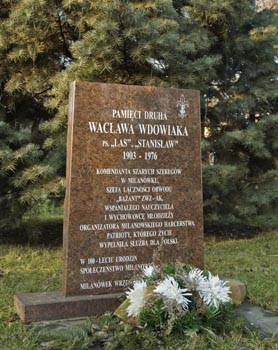
17. Villa "Pod Dębem", at 4 Wspólna str.
Lt Col Franciszek Jachieć, a professional officer and Vice-President of the Polish Football Association (PZPN) lived here with his family. During the time of occupation, he served as Commander of the Western Warsaw District of the Home Army – an area that included the grójecki, błonski, sochaczewski, skierniewicki and łowicki powiats. After the war he was forced into hiding for several years away from Milanówek. After his return, he was arrested by the Security Forces in 1951. The building was erected in 1912.
18. Villa „Starodrzew”, at 2 Kaprys str.
During the time of occupation, a radio station was hidden in this house and used during the absence from the villa of the Germans living there. The radio operator was a former school janitor, Corporal Franciszek Rasztawicki. The cadet training school Agrykola held sessions here for the Storm troopers of the Szare Szeregi section of the Home Army. The villa was built in 1913.

19. Villa „Rysinek”, at 6 Wójtowska str.
Ryszard Csáky, leader of the Home Army 52nd Platoon and Jerzy Csáky, deputy leader of the 32nd Platoon lived here. During rebuilding work in 1990, a large supply of weapons and a hand gun was uncovered here. The weapons were passed by the police to the Polish Army Museum. The villa was built in the years 1912-1913.
20. Villa „Janotka”, at 8 Zaciszna str.
At the end of 1945 – immediately after the Soviet army had entered Milanówek - the villa was taken over by NKWD and UB and a temporary prison set up in the basement where many arrested members of the Home Army were held. The villa was built in 1930.
21. Villa „Podgórze”, at 25 Wspólna str. (During the war: No 4a)
In this villa lived the Minkwitz family, all of whom were actively involved in subversive activity in the ranks of the Home Army. The headquarters of the Special Operations Division of the Home Army 52nd Platoon was located here. At all times there were in the house people fully prepared for combat: other members of the Division were called in as needed for specific tasks. The villa was built in the years 1926-1927.
22. Villa „Henrysia”, at 3 Piasta str.
Villa belonging to the family of Feliks Dzierżanowski, founder and director of the well-known Polish Folk Band. During the occupation, his children - Halina, Jadwiga and Feliks – were involved in subversive activities with the scouts and later with the Home Army. In their home were held scout meetings and cadet training sessions as well as a range of secret teaching lessons. On the ground floor of the villa lived Barbara Staniszówna and her mother: the former was a member of WSK AK (Women’s Armed Service of the Home Army). In her flat were carried out checks for the headquarters of the Home Army Bazant area. The villa was built in 1928.
23. Villa „Halinówek”, at 4 Krasińskiego str.
Property of the Markowski family. Władysław Markowski was an employee of the Foreign Department of the Government Delegation for Poland. The highest civilian representatives of the Polish Underground State spent time here. His son Stanisław and daughter Helena fought in the Home Army. When necessary, the villa housed members of the Home Army preparing for action. Lectures for the underground Western Territories University also took place here as well as lessons covering the entire secondary school curriculum. The villa was built in 1926.

24. Building of School Assembly No 1, at 14 Piasta str.
There’s a plaque in the building to commemorate 56 teachers participating in secret teaching organized during the German occupation in Milanówek in the years 1940-1945. Under their names there’s an inscription reading: Thanks to courage of people like Them our Nation managed to avoid a civilization disaster. May their names live on – grateful students. The plaque was funded by doctor habilitated Andrzej Jaczewski, son of Stefan Jaczewski - High School headmaster of many years and organizer of secret teaching.
25. Stefana Starzyńskiego Square, at Kościuszki str.
The first memorial erected after the war in honour of those who fought for freedom in Poland was designed by the architect, Czesław Piwowarczyk and placed here at the end of the 1950s. It was soon demolished and its place taken by a new memorial, Pomnik Bohaterów (Memorial to the Heroes). This commemorates the Polish struggle for independence on the various fronts of World War II and the martyrdom of the Polish nation. On the stone wall surrounding the memorial is a plaque with the names of places where people from Milanówek fought. The memorial, designed by Professor Stanisław Kulon and Mieczysław Borys, was unveiled on 02.09.1985. In 2003, a stone memorial, Golgotha of the East was added: this gives the names of Polish martyrdom site. The most important patriotic celebrations and anniversaries traditionally take place here.
.jpg)
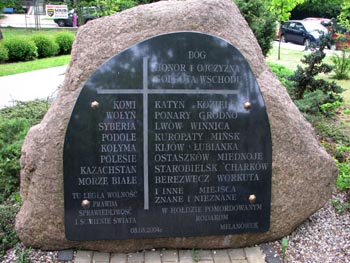
26. St Jadwiga Śląska Church and parish house, at 40 Kościuszki str.
The memorial plaques on the walls of the church include one commemorating Gen Brig. E. A. Fieldorf (codename Nil), Deputy Commander-in-chief of the Home Army, leader of the Kredyw Section of the Home Army; one in honour of all members of the Home Army; and one commemorating the Scout Movement, Szare Szeregi. In the presbytery in September 1939 there was a field hospital which continued to operate until the surrender of Warsaw. During the German occupation the senior priest was Jerzy Modzelewski, later Bishop Jerzy Modzelewski. During the Warsaw Uprising, the Warsaw Metropolitan Curia and the Archbishop’s Court were located in the parish. An urn containing the heart of Frederick Chopin was brought to the presbytery in September 1944. In 1945, the urn was ceremoniously transported to Św. Krzyża Church in Warsaw. The church building was completed in 1912 and extended in 1949. The presbytery was finished in 1939.
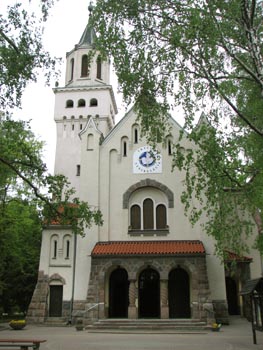
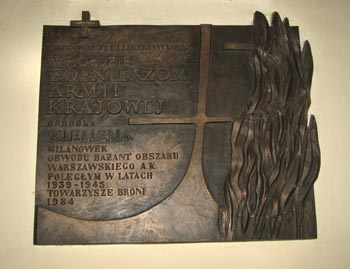
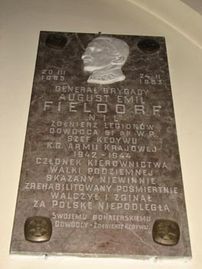
27. Villa "Basieńka", at 3 Mickiewicza str.
Headquarters of Captain Zygmunt Dąbrowski (codename Bohdan), the Deputy Leader of the Home Army District. He died on 29th July 1944 during an attempt to rescue the Home Army District Commander, Major Alojzy Mizera who had been unwittingly arrested by the Germans. His wife, Halina Dąbrowska, was a liason between Bohdan and the Deputy Commander of the Women’s Armed Service section of the Home Army.
28. Villa "Kwieka", at 15 Literacka str.
This building was built in 1930 and its first owner was Hippolytus Kwiek. In January 1945 after the occupation of Milanówek by the Red Army, the Soviet military Commander Cpt. Mazur based his headquarters here: he is credited with creating the term “Little London”. The house also housed the main Milanówek base of NKWD. Interrogations of arrested members of pro-independence conspirators were held here.
29. Villa „Mironówka”, at 7 Literacka str.
The villa housed the first experimental laboratory of Miron Krasnodębski, a soldier in the Mielizna Wing of the Home Army (Bazant Area). M. Krasnodębski became famous for producing mercury fulminate used as a primer for detonating hand grenades (1942-1944). According to history textbooks about the Second World War, the mercury fulminate of Miron Krasnodębski was delivered to various sections of the Home Army as well as insurgents in the Warsaw Uprising and served well in the fight with the Germans. The villa was built in 1910-1913.

30. Building of the Primary School No 2, at 20 Literacka str.
In 1952 Primary School Number 2 was moved to a new building. On 22nd May 2000 it was given the name “Home Army” to commemorate the contribution made by teachers, pupils and former pupils in the ranks of the Home Army, Szare Szeregi and Women’s Armed Service in the struggle with Hitler’s occupying forces. A standard was given to the school funded by former pupils. Prior to being given the name Home Army, a memorial plaque had been placed on the front of the school building funded by former pupils to commemorate Wacław Wdowiak’s many years of teaching in the school: he was Commander of the Hufiec Szare Szeregi and leader of the liaison wing of the Home Army Bazant area. The school building was built in 1952.

31. Plaque at Armii Krajowej Square, at Kościuszki str. and Sienkiewicza str. corner
Memorial plaque commemorating the fighting of the Home Army in Milanówek. The square was named “Home Army Square” and the first plaque unveiled on 21st June 1994.
To commemorate soldiers of
The Polish Underground State
fighting in the area of Milanówek
during world war II
1939-1945
in the following underground formations:
ZWZ-AK Błonie „Bażant” District
ZWZ-AK Milanówek „Mielizna” Unit
„Bażant” District „Kedyw” Unit
Line Platoons 32, 51, 52 0 10 pp. AK
AK Officer Cadet School „Agrykola”
Training School for Non-commissioned AK Officers - „SMD”
Women’s Military Service
Szare Szeregi District „Milion”
in Milanówek
Secret teaching and
underground press printing
Polish Military Organization
National Military Organization
and other organizations
subordinated to the Polish Underground State
and acting temporarily in Milanówek
in 1944.
Headquarters of AK „Hajduki-Hallerowo” District
And Warszawa–West – from July 1944.
Insurgent’s hospitals – from August 1944.
Government Delegate’s Office at Home – from October 1944
Part of the AK Headquarters – from October 1944
[anchor in the left-hand corner]
The plaque was exposed on 25th May 2002

32. Villa „Uzarówka”, at 70/72 Podgórna str.
Adam Bień and his family lived on the first floor of this house from before the war: Adam Bień was a Minister in KRM (National Council of Ministers) and First Deputy in the Government Delegation for Poland. He was one of the sixteen representatives of the highest authority of the Polish Underground State arrested by NKWD and deported to Moscow. Meetings of the leaders of the Polish Underground State were held in his flat. In one of the rooms was a hiding place under the floor where secret documents mainly relating to ethnic relations in Poland were stored. Many years later, at the age of 97, Adam Bień uncovered the hiding place and the documents were ceremoniously handed over to the Jagielloński Library in Cracow. On the second floor lived Alojzy Rybiński who was the weapons officer for the Home Army Bazant area. He was arrested on the day when the Home Army arsenal in Ponder Wood was destroyed by the Germans.

33. Plaque commemorating Deeds of Szare Szeregi, at Kościuszki str. and Szarych Szeregów corner [reproduction]
This plaque commemorates the fighting by the youngest members of the Home Army; it was initiated and funded by Zygmunt Mieszczak (codename Tadek).The plaque was unveiled on 11th November 2007.
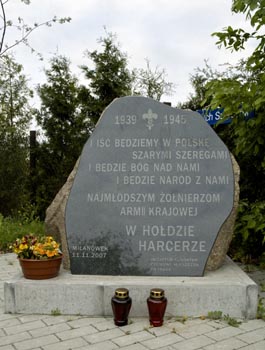
34. Villa, at 10 Wigury str.
The villa belonged to Weronika and Henrya Olesiński and housed a radio moitoring station. In September 1943, a secret printing press was moved into the basement from Grodzisk Maz.: publications included Weekly Chronicle and London Calling. The villa also housed one of several radio stations in Milanówek on which encoded messages were sent to London. The villa was built in 1936.
35. Parish cemetry, at Wojska Polskiego str. and Podgórna str. corner
The cemetery was established in the early days of September 1939 after a battle in Milanówek in which soldiers of the Polish Army lost their lives: these were the first to be buried here. (kw. XI-1/14-24). In the cemetery can be found numerous graves of Home Army soldiers including some who were killed in Milanówek (kw. XII-1b/3; XII-1).
A mass grave holds ashes from Auszwitcz and Pawiak, symbolizing the graves of 28 inhabitants of Milanówek who were murdered in the camps and prisons in 1940-1944 (kw.XII-1b/4).
There are also graves of those who took part in the Warsaw Uprising and who died from their wounds in the hospitals in Milanówek between September 1944 and July 1945. (kw. XXVII).
[The Roman number is for the section, the second number – for the grave line and the third number – the grave number in the line. Sections numbered with odd numbers are located left to the main avenue, while the even ones – on the right]
First burials took place on 9th September 1939 while on 23th October 1939 the cemetery was formally consecrated.
36. "Pondra" Forest, at Wojska Polskiego str. (earlier Mały Chrzanów village)
The site of a Home Army weapons arsenal. The arsenal was located in the basement of an unfinished house belonging to Corporal Tomasz Ponder (codename Tomek). Weapons from various sources were stored there. Following a betrayal, the Germans surrounded the arsenal on the night of 9th July 1944; the group were murdered and burned and the arsenal blown up. Amongst those murdered was the well-known doctor, Franciszek Grodecki who was in charge of the Medical Wing of the Bazant Operational area of the Home Army: he was taken from his own home. The graves of those murdered can be found in the Milanówek cemetery.

37. Villa „Waleria”, at 20 Spacerowa str.
Property of the well known sculptor, Jan Szczepkowski and his wife, Maria Morozowicz-Szczepkowska who was an actress and writer. Their daughter, Hanna Mickiewiczowa, also lived there with her husband, Adam. During the time of occupation, Lt./Capt. A. Mickiewicz was in charge of the Industrial Wing of the Home Army Headquarters. His wife Hanna was a special assignments liaison officer. Reports from spies about industry in the Third Reich came into the Wing in the years 1942–1944. After the Warsaw Uprising, famous representatives of Polish culture found shelter in the Szczepkowski home. The Villa was built in 1912.
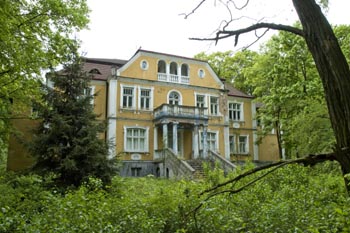
38. Villa „Matulinek”, at 10 Mickiewicza str.
This villa was left to the Ursulanki Sisters under the will of Maria Watraszewska. During the war, the Sisters ran a boarding school for secondary school pupils. They participated in providing secret teaching. They worked with the Home Army. They gave help to people hiding from the Gestapo. They concealed Jewish children. After the Warsaw Uprising, they organized help for refugees. The villa was built in 1910.
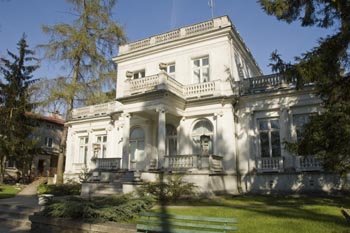
39. Villa „Dworek Dęby”, at 11 Mickiewicza str.
From 1942, the villa - made available by Countess Maria Mohl - was used by the Ursulanki Sisters. During the war they distinguished themselves by their outstanding involvement in work for the community. From the time of the war, they ran a pre-school in this house. The Villa was built in 1908.
40. Villa „Romin”, at 16 Królowej Jadwigi str. (During the war: No 8)
Throughout the war, a full range of secret teaching was organized in the villa. In the attic was housed the editorial office and printing press for the Scouts’ publication, Zawiszak, the first Milanówek edition of which appeared on 1st December 1944. The villa was built in 1928-1929.
41. "Summer Theatre", at 3 Kościelna str.
Cultural centre in pre-war times. During the Warsaw Uprising, it offered emergency medical assistance and shelter to hundreds of refugees from Warsaw and the transit camp in Pruszków. At the end of 1944, patriotic concerts were held here with the participation of well-known artists from the Warsaw artistic scene who were at that time in Milanówek. The summer theatre was built in 1909.
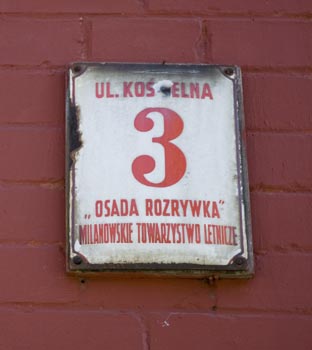
42. Villa „Lusia”, at 11 Słowackiego str.
In the flat of the Deputy Headmaster of the secondary school, Stefan Jaczewski was located the main coordination point for all the secret teaching undertaken throughout Milanówek. From 1942 one of the bases of the secret scout movement, Szare Szeregi was based here: Stefan Jaczewski’s son, Andrzej (codename Sowa), was actively involved in their work. Briefings, meeting and training sessions of the Scouting Organization, Szare Szeregi took place here. The villa was built in 1927.
43. Villa „Bożenka”, at 3 Spacerowa str.
Before the war and during the war, this building housed the Co-educational Gimnazjum and Liceum (Secondary schools). In September 1939, the building was used as a German barracks and field hospital. During the occupation, a School of Economics operated here. During the Warsaw Uprising, a hospital (Szpital Dzieciątka Jezus) was evacuated here from Warsaw: it provided help to about 400 patients. Dr Wilhelm Czarnocki directed the hospital’s work. In postwar years, the Gimnazjum and Liceum were moved to other premises and Gen. E. A. Fieldorf Primary School Nr 18 was opened. In 2006, a memorial plaque was unveiled, commemorating all the teachers who had taken part in the secret teaching in Milanówek.

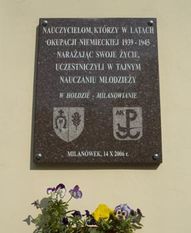
44. Villa „Wildowa”, at 1 Spacerowa str.
In this villa, which was known colloquially by secondary school pupils as Folwark, was housed a grocery shop run by the owner of the house, Home Army Corporal, Edward Dobrowolski (codename Stary). During the occupation, an underground food store for the Home Army was located beside the shop. The remainder of the building was occupied by an officially recognized vocational school. Under the guise of vocational training, general education classes were also organized in secret. On 18th July 1942, a founding meeting of the Szare Szeregi (a subversive scouting movement) was held.

45. Villa „Maria”, at 1 Żabie Oczko str.
During the German occupation, the villa housed the headquarters of the Central Welfare Council (RGO). There was a children’s day centre run by religious sisters. During the Warsaw Uprising, a wide range of charitable work was organized to provide food and distribute clothing. The villa was built before the First World War and extended in the 1950s.

46. Villa ”Helena”,”Elle”, at 19 Krakowska str.
During the war, Sergeant Wacław Wdowiak (codename Las) lived here. He was a teacher and commander of the Hufiec Szare Szeregi (a subversive scouting movement). In his home was housed a secret printing press as well as radio monitoring equipment and the editorial team of the subversive newspaper, Placówka. The printing press was moved to Brwinów because of an imminent risk but the radio monitoring equipment and editorial team remained in the villa.
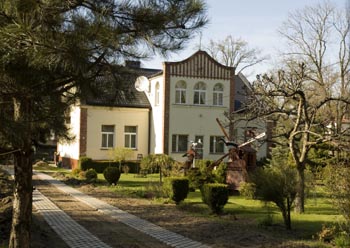
47. A cross and a plaque, at Krakowska str.
A cross and plaque commemorating the events of 29th July 1944. During a round-up, the Germans unwittingly arrested Major Alojzy Mizera, commander of the Bazant operational unit. A tragic series of events during an attempt to rescue the commander resulted in the deaths of Corporal Zygmunt Dąbrowski (codename Bohdan) and Lieutenant Jerzy Kowalski (codename Oskar). The cross was erected in 1994.

Below, extra villas that you can find on this route:
i. Jankowski’s house, at 11 Krakowska str.
After the Warsaw Uprising a first-aid point for the refugees was arranged in here, to provide them with hot meals and necessary information.
The building was built at the beginning of the 20th century.

j. Villa „Leontynówka”, at 13 Krakowska str.
AK Kedyw staff meetings of the „Bażant” District were held in one of the villa apartments which belonged to captain Jan Kisielewski (codename „Junosza”, „Winkiel”).
The villa was built in 1910.

k. Villa „Kresy”, at 3 Słowackiego str.
Children hospital managed by doctor Hanna Tomaszewska was here. There was also a branch of “Dzieciątka Jezus” hospital evacuated from Warsaw with 25 children and 20-person staff to look after them.
The villa was built before the world war I.
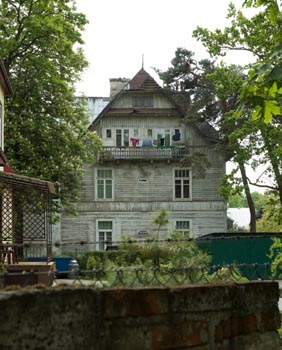
l. Villa „Zacisze”, at 6 Słowackiego str.
Engineer Aleksander Brzuzek lived here with his Swedish wife – Karin before the war. He acted in AK formation and played crucial role in delivering to London documents which showed the truth about Nazi crimes committed in occupied Poland. For that purpose he used his position of director in the Swedish company ASEA seated in Warsaw. Having been decoded by Germans he was sentenced to death by beheading. You can find his symbolical grave at the Milanowski cemetery.
After the Uprising the villa received 120 patients and 60-person staff of the Ujazdowski Hospital evacuated from Warsaw, with doctor Jan Krotoski in charge.
The villa was built in the years 1930-1932.
ł. Villa, at 8 Chrzanowska str.
The underground radio station and radio communication unit of „Mielizna” Unit commanded by cadet Andrzej Kiełkiewicz codename „Baniocha” were established in 1943 in the villa. Here trainings in sending and receiving encoded radio telegrams (in the Morse code) were arranged. Radio watch was also carried out in the villa. Radio Communication became more frequent in the spring 1944, when AK Western Sub-District received better radio equipment from airdrops.
m. Villa „Morawianka”, at 4 Chrzanowska str.
During the war patriotic concerts were organized in the villa., It was mainly Chopin’s music, played and sung by famous pianists and singers, among others Julia Mechówna, Zofia Rabcewiczowa, Jan Sierpiński, Bolesław Woytowicz.
Secret teaching was also organized here.
In the yard shed secret meetings of girl-scouts from „Skrzydlata Kapela” team were conducted by scouting instructors Ola Rogowska and Halina Dzierżanowska.
n. Villa ”Stara Wioska”, at 5 Piasta str.
The place, after its alteration, became the seat of Physiotherapy and Care Centre of the Catholic Association for the Disabled to the Warsaw Archdiocese. The villa used to belong to the Mierzejewski family. During the war several patriotic concerts were organized here, with the participation of world famous musicians, among others, Zofia Rabcewiczowa, J. Dubiska, Eugenia Umińska, professor Zbigniew Drzewiecki, professor Bolesław Woytowicz, Witold Lutosławski, Andrzej Panufnik, Maria Wiłkomirska, Kazimierz Wiłkomirski and Włodzimierz Mierzejewski.
o. Villa „Słoneczna”, at 4 Wspólna str. (Turing the war: No 15) (in the breakdown)
In 1940 a local underground paper called “Placówka” started to be published by certified lieutenant-colonel Franciszek Jachieć who lived in the villa. Between 1942 and 1944 the villa housed headquarters of the AK Western Sub-District commander – F. Jachieć.
The villa was built in 1912.
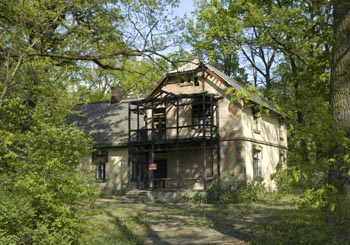
p. Felicja Witkowska’s Photogrophic studio, at Dworcowa str. (doesn’t exist any more)
During the inter-war period, through the whole occupation and a few years after the war there was Felicja Witkowska’s Photogrophic studio. The owner became well known as a photo-chronicler of Milanówek. With her camera she recorded many people and events of those days, among others, of the war period. After the Warsaw Uprising collapse her studio became a ”bedroom” for refugees. Wooden atelier was a shelter of a Jew-fugitive from Pawiak, for whom a special ground-shelter was dug behind so called canvas „backgrounds”. Together with her children she looked after other two Jewish prisoners from Pawiak, who arrived to Milanówek (injured) after the Uprising together with other refugees. In 1993 upon the request of the three rescued (one lived in the USA where he died in 2001, the other one – in France and the third one – in Germany) the Yad Vashem Institute in Yerosolima awarded “Righteous Among the Nations” medal to F. Witkowska (post-mortem) and her children Aniela and Ryszard, and in 1994 – a honorable citizenship of the Israel Country. From October 1944 after the Uprisings, when the Government Delegate’s Office at Home „settled” here for a while, her photo shop collaborated with AK „Foto” Unit run by Wacław Żdżarski) on, among others, microfilms processing. A very little known fact is that F. Witkowska took a picture to be used in a false Kennkarta for the AK commander-in-chief, general Leopold Okulicki – „Niedźwiadek”.
r. Villa „Róża”, at. 17 Piasta str. (second entrance door from Wspólna str.) (doesn’t exist any more)
In the (currently ruined) villa which used to belong to Anna Spasowska-Dryńska, a left-wing underground group „Młot i Sierp” (Hammer and Sickle) was seated. Romuald Spasowski and Mirosław Nadelwicz-Kremky were two of its members. The group contributed significantly to help Jews during the war. Many people were saved and two Jewish families (the Posławskis and the Burases) lived here during the whole period of the German occupation. After the war A. Spasowska-Dryńska was awarded the „Righteous Among the Nations” medal by the Yad Vashem Institute.
The villa was built before 1914.
s. Villa, at 24 Słowackiego str. (in the state of rebuilding)
After the Uprising a daily informative bulletin „Wiadomości radiowe” (Radio news) was issued here. The bulletin contained the news which came from the BBC Radio watch. Until the end of February 1945 the position of chief editor was held by Józef Stemler-Dąbski and then the position was taken over by a historian professor doctor habilitated Zygmunt Wojciechowski, director of the Information Department.
t. Villa of Garstecki’s family, at Czubińska str. and Zielona str. corner (doesn’t exist any more)
From June to October 1940 the villa housed the Maltan Hospital (so called House for the Recovered) under the name of the Polish Red Cross (PCK) with its 20 patients – mainly injured during the defence of Warsaw as well as several PCK nurses recovering after hard work in Warsaw. The patients included military men from different parts of Poland.
*
Today, after so many years have passed, it is hard to believe that in the autumn 1944 it was possible to create in Milanówek conditions for temporary accommodation for thousands of Warsaw refugees and to house many hospitals and a huge orphanage of Rev. Baudouin evacuated from Warsaw, at the time the Warsaw Uprising was dying down, the war still wasn’t over, there was no basic medical stuff or food and the conditions were less than poor. The credit for that didn’t just go to devoted doctors and nurses who came to Milanówek with their patients, but also to Milanówek residents and the good will of hundreds of farmers and landowners from nearby villages who voluntarily came for help providing food, dressing and medicines. The contribution of AK soldiers from „Mielizna” Unit as well as scouts from Szare Szeregi and girl-scouts from underground teams to successful organization of life in our city was crucial.
Working conditions of doctors, nurses and helping staff were extremely hard. They were working non-stop, days and nights, for hardly any food and no money. It was a great, spontaneous fight for people’s lives, for the sick and the injured. We should be aware of this when visiting commemorative places of “Little London” so that superhuman effort, devotion and work of doctors, nurses and local people remain in the memory of future generations.
The contents of the walk around the memorial places related to the traces of the Second World War in Milanówek were
developed by Andrzej Pettyn
Bibliography of publications on the world war II in Milanówek:
- Andrzej Stawarz, dr (red.); A. Góralski, A. Kołodziejczyk, A. Stawarz, R. Turkowski „Zarys dziejów Milanówka”, wyd. Urząd Miasta Milanówek 1995
- Tadeusz Sowiński „Jedwabna konspiracja”, Burchard edition, W-wa 1998
- Andrzej Pettyn „Kiedy Milanówek był stolicą…”, Milanówek SIT 2000
- Andrzej Pettyn „Milanówek – Mały Londyn”, TMM 2004
- Andrzej Pettyn „Milanówek – miejsce magiczne”, TMM 2005
- Zofia Żuławska „Parafia św. Jadwigi w Milanówku”, TMM 1998